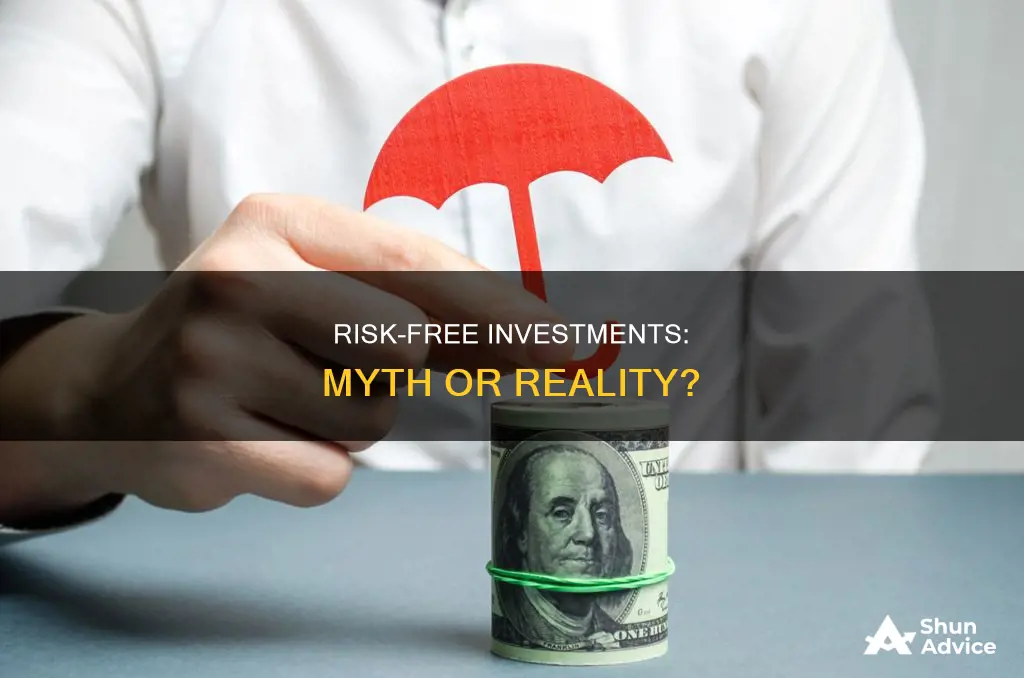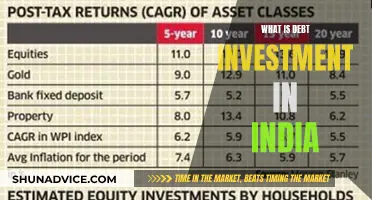
There is no such thing as a completely risk-free investment, but there are options for those who want to limit their exposure to risk. These include money market accounts, certificates of deposit, cash management accounts, high-yield savings accounts, and Treasury bills, notes and bonds. All of these options carry FDIC insurance or are backed by the US government, making them relatively low-risk. However, the trade-off for lower risk is often lower returns, and inflation can erode the purchasing power of money invested in low-risk assets.
| Characteristics | Values |
|---|---|
| Risk level | No risk, some risk |
| Returns | Lower returns than riskier investments |
| Time horizon | Short-term, long-term |
| Access to funds | Immediate, locked-in |
| Inflation impact | Erosion of purchasing power |
What You'll Learn

High-yield savings accounts
- Annual Percentage Yield (APY): High-yield savings accounts offer a higher APY than traditional savings accounts, allowing your money to grow faster. The APY can be up to 15 times higher than the national average, and some accounts may offer a promotional rate for a limited time.
- Fees and Minimum Requirements: While some high-yield savings accounts have no monthly fees or minimum balance requirements, others may charge fees or require a minimum balance to earn the advertised APY. It is important to carefully review the terms and conditions before opening an account.
- Withdrawals and Transfers: High-yield savings accounts typically allow you to withdraw and transfer funds without any penalty, providing easy access to your money. However, there may be limits on the number of withdrawals or transfers you can make per statement cycle, and some accounts may charge excessive transaction fees.
- ATM Access: Some high-yield savings accounts offer optional access to an ATM card, allowing you to withdraw cash. However, there may be limits on the number of transactions or amounts you can withdraw.
- Interest Rate Changes: It is important to note that the APY on high-yield savings accounts can change at any time. These accounts offer variable interest rates, which means the rate can go up or down, especially if the Federal Reserve adjusts the federal funds rate.
- Comparison with Other Investment Options: High-yield savings accounts offer higher returns than traditional savings accounts, but they may not be the best option for long-term wealth generation. For retirement planning or long-term goals, working with a financial advisor or broker to develop an investment portfolio may be more suitable.
Overall, high-yield savings accounts can be a great option for those seeking a safe and low-risk way to grow their money. They offer higher returns than traditional savings accounts and provide easy access to funds, making them ideal for short-term financial goals and emergency funds. However, it is important to carefully consider the features and potential drawbacks before opening an account.
Motivating Workers: A Manager's Key to Success
You may want to see also

Money market funds
Additionally, money market funds offer instant diversification among a range of securities. Investors don't need to select and invest in various money market securities individually, which can be an important safeguard for a portfolio. Money market funds are also highly liquid, allowing investors to buy and sell them with comparative ease.
However, there are some potential downsides to money market funds. The income received from a money market fund investment will fluctuate up and down based on the yields available on the underlying securities. The money invested in money market funds is also not protected by the Federal Deposit Insurance Corporation (FDIC) or the National Credit Union Association (NCUA). While the Securities Investor Protection Corporation (SIPC) provides some degree of financial protection for investors, it only replaces the investments when possible.
It's important to note that money market funds are not ideal for long-term investing due to their low returns and lack of capital appreciation. They are more suitable for individuals looking to invest for the short term or those who are close to or in retirement and need access to their money soon.
Investing vs. Saving: Which is Riskier?
You may want to see also

Certificates of deposit (CDs)
CDs are a good option if you want to protect designated savings. They are also a good choice if you want returns without much risk and want to avoid the volatility of the stock market. The national average rate for a regular savings account is 0.41%, far below the average rate for a five-year CD of 1.32% annual percentage yield.
CDs have a typical minimum balance, or minimum deposit, of $1,000, though the minimum ultimately depends on the bank. Standard CD minimums can range widely, such as from $0 to $10,000, and jumbo CDs traditionally have minimums of $100,000.
CD rates are in terms of annual percentage yield, or APY. This is the annual interest rate after compounding. The interest earned in a CD is usually compounded and paid to the account, generally daily or monthly, and you receive it all when the CD term ends. You can also choose to receive regular interest payments if the bank allows it.
CDs tend to have higher rates than regular savings accounts but don't allow access to your money until the term ends. If you need your money before the CD's term ends, you'll likely pay an early withdrawal penalty, which can significantly reduce the interest you earned on the CD.
Equity Investment: Show Proof with These Simple Steps
You may want to see also

Treasury securities
While Treasury securities are considered low-risk, they do come with some risks, such as being impacted by inflation and changes in interest rates. Treasury securities typically pay lower interest rates than other securities, and there is a risk that investors could have earned better returns elsewhere.
Charities and VAT: Investment Management Fees Explained
You may want to see also

Bond funds
While bond funds provide monthly returns, these can be inconsistent, and there may be initial sales charges and additional management fees. Despite the diversification benefits of mutual funds and ETFs, their value can fluctuate based on market conditions, making them riskier than savings accounts or government-backed bonds, especially for short-term investments.
There are several types of risks associated with bond funds. Interest rate risk refers to the potential for a bond's value to fall in the secondary market due to competition from newer bonds with more attractive rates. Reinvestment risk is the possibility that the cash flow from a bond will be reinvested in new issues with lower yields. Call risk is the likelihood that a bond issuer will exercise its option to retire the bond early if interest rates fall. Default risk is the chance that the bond issuer will go bankrupt and be unable to meet its financial obligations. Lastly, inflation risk is the possibility that inflation will erode the value of a bond's fixed-price issue.
War Fears: Investing Amid India-Pakistan Tensions
You may want to see also
Frequently asked questions
No investment is entirely risk-free. Even with cash and government bonds, there is a risk of inflation outpacing the yield, leading to a decrease in purchasing power over time. However, some investments are considered low-risk, such as high-yield savings accounts, money market funds, and certain types of bonds and annuities.
Low-risk investments offer stability, predictable income, and protection against market volatility. They are particularly appealing to risk-averse investors, those nearing retirement, or anyone looking to balance out higher-risk investments.
Some examples of low-risk investments include high-yield savings accounts, money market funds, certificates of deposit (CDs), Treasury securities, investment-grade corporate bonds, and annuities. Each of these investments has its own unique features, returns, and risks that should be considered before investing.







